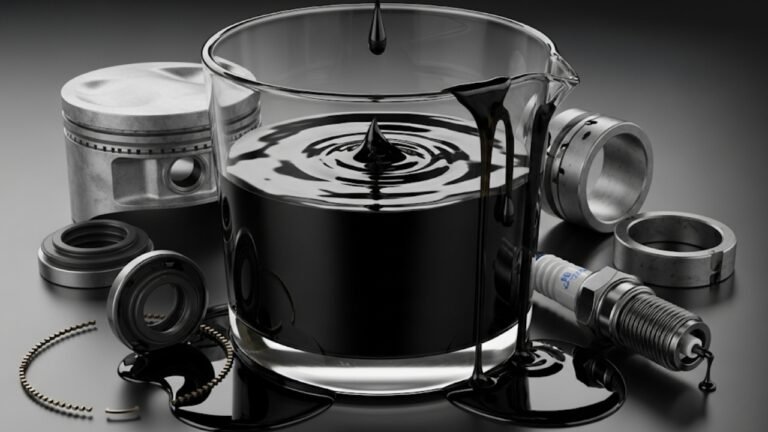What Happens If There’s a Little Bit Too Much Oil in a Car?

Ever topped off your engine oil and thought, “Eh, just a little more won’t hurt?” You’re not alone. Many drivers have done it, thinking it’s better to have a little bit too much oil in the car than not enough. But here’s the thing—more isn’t always better, especially when it comes to engine oil.
Engines are like finely-tuned instruments. A slight change in the oil level can impact how they perform. That little extra oil may seem harmless at first, but it can cause problems over time. From foaming and pressure issues to seals blowing out and even full-on engine damage—overfilling the engine oil, even just a tad, can lead to a series of domino effects.
This article explores what really happens when you have a little bit too much oil in a car, shares some personal stories, gives practical advice, and answers the most common questions drivers have. Whether you’re a beginner or a seasoned car owner, this guide is your go-to resource.
In This Article
- 1 Why Engine Oil Levels Matter So Much
- 2 Symptoms of Slight Overfilling: What to Watch For
- 3 Here’s a Quick Look: Normal vs Overfilled Oil
- 4 How Much Is “A Little Too Much”? Let’s Define It
- 5 Personal Story: A Lesson from My First Car
- 6 Common Mistakes That Lead to Slight Overfilling
- 7 How to Check If You Overfilled (and Fix It Fast)
- 8 Long-Term Effects: What If You Keep Driving With Too Much Oil?
- 9 Preventing the Problem: Small Habits, Big Impact
- 10 Emotional Angle: It’s Not Just About Oil—It’s About Trust
- 11 DIY Guide: How to Remove Excess Oil Safely
- 12 Environmental Warning: Dispose of Oil the Right Way
- 13 Quick Recap: The Good, The Bad, and the Oily
- 14 FAQs: Answers to Common Questions
- 14.1 1. Can I drive short distances with a little too much oil in my car?
- 14.2 2. How much oil overfill is dangerous?
- 14.3 3. Will a little extra oil burn off naturally?
- 14.4 4. Is it better to have too much oil than too little?
- 14.5 5. What should I do if I suspect I’ve overfilled but have no symptoms?
- 14.6 6. Can a mechanic fix it fast?
- 14.7 7. Will my warranty be void if I overfill the oil?
- 14.8 8. How do I know the exact oil capacity for my car?
- 15 Final Thoughts: A Little Goes a Long Way—In Both Directions
Why Engine Oil Levels Matter So Much

When there’s a little bit too much oil in the car, it increases the pressure inside the crankcase. Think of it like overfilling a balloon. At first, it’s fine. But push a little too far, and things stretch and pop.
The oil may foam up due to contact with the crankshaft, leading to air bubbles. And guess what? Foamy oil doesn’t lubricate well. It loses viscosity, making your engine parts grind and heat up. Even worse, seals and gaskets can leak due to the pressure.
Let’s break it down into what oil is supposed to do:
-
Lubrication: Reduces friction between engine parts.
-
Cooling: Draws heat away from moving components.
-
Cleaning: Carries debris and contaminants to the oil filter.
-
Protection: Prevents rust and corrosion.
So, when oil is overfilled, each of these jobs gets compromised.
Symptoms of Slight Overfilling: What to Watch For
You may be thinking: “But it’s only a little over the line!” Sure, it may not kill your engine overnight, but you’ll notice subtle symptoms that your car is not happy.
Here’s what to keep an eye on if you suspect there’s a little bit too much oil in the car:
-
Blue smoke coming from the exhaust
-
Rough idling or engine misfires
-
Burning oil smell
-
Oil leaks under your vehicle
-
Check engine light or oil warning light
Each of these symptoms points to a potential oil-related issue. For instance, the blue smoke? That’s oil burning in the combustion chamber, which shouldn’t be happening.
Personally, I once topped off my engine thinking it was low, only to end up seeing smoke after a long drive. It wasn’t dramatic at first, but over time, my seals started leaking. I learned the hard way—even a small overfill can cause expensive damage.
Here’s a Quick Look: Normal vs Overfilled Oil
| Factor | Normal Oil Level | Slightly Overfilled Oil |
|---|---|---|
| Lubrication Quality | Optimal | Compromised (foamy) |
| Oil Pressure | Stable | Increased pressure |
| Engine Seals | Safe | Risk of leaks or blown seals |
| Fuel Economy | Efficient | Slightly reduced |
| Emissions | Controlled | Risk of burning oil (blue smoke) |
Notice how just a little bit too much oil in the car tilts everything from “just right” to “problematic.” It doesn’t have to be overflowing to do damage.
How Much Is “A Little Too Much”? Let’s Define It
This is where most confusion comes in. What exactly counts as “a little”? Half a quart? An inch above the dipstick line?
Mechanics generally agree that up to ¼ inch above the full line on the dipstick might not cause harm in most modern engines. But even that depends on your engine size and design. A small 4-cylinder engine has less tolerance for overfill than a bigger V8.
Here’s a guideline:
-
Up to ¼ inch above dipstick: Often safe, but monitor symptoms.
-
½ inch or more above: Risk of foaming and damage.
-
Full quart or more: Needs to be drained immediately.
Remember, modern engines are built with tight tolerances, especially turbocharged ones. So even a small overfill can be critical.
Personal Story: A Lesson from My First Car
I’ll never forget the first car I owned—a 2001 Toyota Corolla. I was eager to take care of it, so I did my own oil change. In my excitement, I poured a bit too much oil—maybe half a cup extra.
At first, everything seemed fine. But a week later, I noticed a burning smell after driving longer distances. Eventually, a mechanic found the oil had foamed and started leaking past the valve seals. It wasn’t catastrophic, but it cost me a few hundred bucks to fix.
Moral of the story? Trust the dipstick. Don’t eyeball it. Even if you’re just over by a little, you’re playing with fire.
Common Mistakes That Lead to Slight Overfilling
It happens to the best of us, and usually for one of these reasons:
-
Not waiting before checking the dipstick: Oil needs time to settle after the engine is off.
-
Pouring too fast: You might misjudge how much you’ve added.
-
Misreading the dipstick: It’s easy to mistake reflections for oil levels.
-
Topping off too often: If you check frequently and add a bit each time, it adds up.
These little mistakes can result in a little bit too much oil in the car, especially if you’re topping up without checking properly.
How to Check If You Overfilled (and Fix It Fast)
Checking oil isn’t rocket science, but doing it right makes all the difference. Here’s how:
-
Park on level ground and let the engine cool for at least 5–10 minutes.
-
Pull out the dipstick, wipe it clean, reinsert, and pull again.
-
Read the level carefully. If it’s over the “full” mark, you’ve overfilled.
If you did overfill:
-
Use a syringe pump or turkey baster through the dipstick tube to remove small amounts.
-
For more than half a quart over, you may need to loosen the oil drain bolt slightly to let some out.
-
In extreme cases, do a full oil change to reset the level.
Long-Term Effects: What If You Keep Driving With Too Much Oil?
You might not notice anything right away. That’s what makes a little bit too much oil in a car so sneaky. It hides under the radar until one day—boom—you’ve got a leak, a blown seal, or worse, a damaged catalytic converter.
When oil gets whipped into foam, it loses its lubricating properties. That means your engine parts rub together with more heat and friction. Over time, this leads to premature wear. Think of it like running a marathon in sandals. Sure, you can do it, but you’ll regret it afterward.
If oil finds its way into the combustion chamber, it can:
-
Damage spark plugs
-
Cause knocking or misfiring
-
Clog the catalytic converter
-
Trigger the check engine light
And if this continues, your engine’s lifespan can drop significantly. What could’ve been a $50 fix becomes a $1500 repair. All because of a few extra ounces of oil.
Preventing the Problem: Small Habits, Big Impact
Let’s be honest. Mistakes happen. But if you build a few habits into your oil-checking routine, you’ll never deal with this again.
Here are some simple prevention tips:
-
Always check your dipstick twice after adding oil.
-
Keep a funnel in your trunk—avoid spills and overpours.
-
Know your car’s oil capacity. It’s in the owner’s manual.
-
Don’t top off too often. If it’s near full, leave it alone.
-
Mark your last oil level. Use tape, notes, or even an app.
When you get into the rhythm of checking oil with care, your car runs longer and smoother. Trust me, it’s worth those extra two minutes.
Emotional Angle: It’s Not Just About Oil—It’s About Trust
I know this might sound dramatic, but your car relies on you. It can’t speak, so it shows signs—smoke, smells, warning lights. Ignoring these is like ignoring a friend who’s trying to tell you something’s wrong.
One of my friends once ignored her oil light, thinking, “It’s just a little high. I’ll get it checked later.” A month later, she was stuck on the highway with smoke pouring from under the hood. The mechanic said the foamed oil had gummed up the oil filter and starved the engine. She cried—not because of the money, but because she felt responsible.
So when you notice a little bit too much oil in your car, don’t brush it off. It’s a small mistake, yes—but one that deserves your attention.
DIY Guide: How to Remove Excess Oil Safely
If you’ve overfilled your oil, don’t panic. You can fix it at home with some patience.
Tools you’ll need:
-
Disposable gloves
-
A clean rag
-
Oil extractor pump or turkey baster
-
A drain pan
-
Wrench (for drain plug method)
Two easy ways to fix the problem:
1. Using an Oil Extractor:
-
Insert the tube into the dipstick hole.
-
Slowly pump out oil.
-
Re-check dipstick every few pumps.
2. Loosening the Drain Plug:
-
Place a pan under the car.
-
Loosen the plug (don’t remove it).
-
Let out a small amount.
-
Tighten and check the level again.
Pro Tip: Always measure how much oil you’ve removed so you don’t go too far the other way.
Environmental Warning: Dispose of Oil the Right Way
If you’re draining oil, please don’t pour it down the drain. Used oil is a toxic pollutant. Bring it to your local mechanic or auto shop for recycling.
Overfilling isn’t just bad for your engine—it’s bad for the planet if you handle it carelessly.
Quick Recap: The Good, The Bad, and the Oily
Here’s a quick summary to keep everything in perspective:
What’s Okay:
-
Slightly above the full mark (under ¼ inch)
-
No visible symptoms
-
Temporary—corrected quickly
What’s Not Okay:
-
Over ½ inch above the line
-
Symptoms like smoke, leaks, or rough idle
-
Long-term neglect
What to Do:
-
Use a pump or loosen the plug
-
Check dipstick properly
-
Watch for changes in performance
FAQs: Answers to Common Questions
1. Can I drive short distances with a little too much oil in my car?
Yes, short-term driving might not cause immediate harm if it’s just slightly over. But don’t wait too long to fix it.
2. How much oil overfill is dangerous?
Anything more than half a quart over the recommended level can start causing problems, especially in smaller engines.
3. Will a little extra oil burn off naturally?
Not really. Modern engines are sealed tightly. Unless there’s a leak or engine burning oil already, the excess won’t just disappear.
4. Is it better to have too much oil than too little?
Neither is good. Too little causes friction; too much creates pressure. Both shorten your engine’s life.
5. What should I do if I suspect I’ve overfilled but have no symptoms?
Monitor your oil level and engine performance. If you’re unsure, remove a small amount to be safe.
6. Can a mechanic fix it fast?
Yes. A quick trip to a mechanic can resolve this in 10–15 minutes. Don’t hesitate if you’re not confident doing it yourself.
7. Will my warranty be void if I overfill the oil?
If the overfill leads to engine damage, it could affect your warranty—especially if it’s determined to be user error.
8. How do I know the exact oil capacity for my car?
Check your owner’s manual or look it up online using your car’s make, model, and engine size.
Final Thoughts: A Little Goes a Long Way—In Both Directions
Car care isn’t just about big repairs and fancy upgrades. Sometimes, the smallest habits—like checking your oil level with care—make the biggest difference.
A little bit too much oil in a car might not seem serious, but it’s a classic case of “better safe than sorry.” Pay attention, act early, and treat your engine with respect. It’ll thank you with miles of smooth, worry-free driving.
You don’t need to be a mechanic to prevent damage—you just need to be aware, careful, and a little more mindful. In car care, as in life, it’s all about balance.






